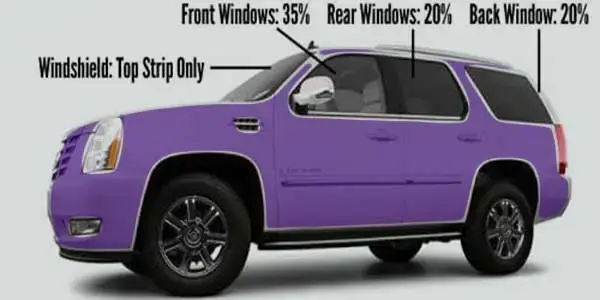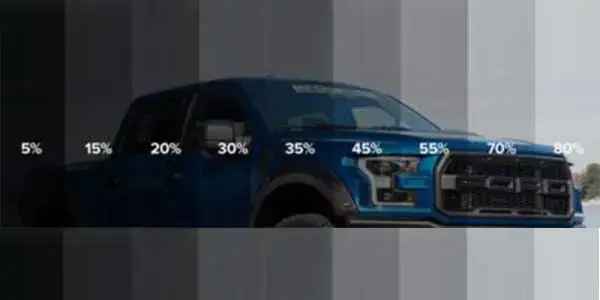If you are a commercial truck driver and looking for the truck window tint laws in states then you are at right place. Window tinting can be very beneficial as it provides you extra sense of security by enhancing your privacy and also protects you from a hazardous UV-rays but it can also cause communication problems for driver and lead towards severe accidents. That’s why there are laws made for the safety of driver that allows a specific amount of tinting. Laws for commercial truck window tinting differ from one state to other, in this article a general overview of tinting laws in different states is discussed.
What is window tint and how is it measured?
Window tint is basically a film applied on the surface of glass of the window of any vehicle. You can apply this tint on either side of window inside or outside. These tints cab made up o0f different kind of materials such as metal, ceramic and polyester. These tints are available in different shades, colors and qualities based on the types of the film.
Window tints can be measured by using two ways one of them is visible light transmission (VLT) percentage which indicated the amount of visible light that can pass through the film. Such as if a 40% VLT film means that it can pass 40% of the visible light through the window tint and remaining 60% will be blocked. The films having lower value of VLT percentage are darker tints and those with higher percentage are lighter tints.
The other method of measuring the tint is by its reflectivity which shows the amount of light that the tint film can reflect away. Films with high reflectivity give mirror like effect on the other hand low reflectivity films appear to be natural.
Commercial trucks on the basis of weight:
Commercial trucks can be categorized on the basis of their weight. Generally, these trucks are divided into three categories.
- Light trucks
- Medium trucks
- Heavy trucks
Light Trucks:
Trucks with a gross weight vehicle weight rating (GVWR) of up to 10,000 pounds are considered as light trucks. Window tint laws for light trucks follow the same rules and regulation as for passenger vehicles.
Medium Trucks:
Trucks with a gross vehicle weight rating (GVWR) in between 10.001- 26,00 pounds are categorized as medium trucks.
Window tint laws for medium trucks are same as for light trucks. Some states can have slightly different law so authenticate first.
Heavy Trucks:
Trucks having gross vehicle weight rating (GVRW) above 26,000 pounds are included in the category of heavy trucks. Due to their heavy weight tint laws for them can slightly vary from state to state.
Window tinting laws for Commercial Trucks
Here is a general overview of laws for trucks window tinting:

Federal Regulations:
The federal motor carrier safety Administration (FMCSA) basically not apply any specific rules for window tinting but, there are certain requirements for the application of window tint for the safety of truck driver.
Visibility Requirement:
Most of the states in America have set regulations regarding the visibility level of the driver that he must have through the window. These laws are generally related to the front side window and rear side window. There is specific percentage of permitted Visible light transmission (VLT) that is the amount of light which can pass through the window.
Windshield Tinting:
For windshield many states allow a non-reflective tint strip only on the top of the range of 5 inches. VLT for this strip is usually more than permitted for other windows.
Front Side Window:
Tint rules are quite strict for front side window (window next to driver and front passenger) as compared to rear window. Typically states allow lower VLT percentage as compared to the front side window.
Rear Window:
Window tint laws for the rear window of commercial trucks are lenient as they allow darker tints.
Reflective Tint:
Highly reflected tints are prohibited by most of the states as they can cause mirror like effect. It can be hazardous for the safety of driver.
Medical Exemptions:
Some states provide the facility of medical exemption, which permits the person with specific medical conditions to have tints that are beyond the limit of regulations
Commercial Truck Window Tint Laws By State
Here is a detailed table which tells us all the allowed limits of window tinting in different states of America.
Frequently Asked Questions
What is the darkest legal tint for a commercial vehicle?
The darkest legal tint allowed for a commercial truck window is a tint film with visible light transmission (VLT) percentage of not less than 35% for front or driver seat window and not less than 20% for rear window.
How dark is 35 percent tint?
35% tint is medium range tint, neither too dark nor too light. Driver can easily see though 35% tint film.
How dark is 15 percent tint?
15% VLT is a dark tint as it only allows 15% light to pass through the window while 85% of the light is blocked.
What is the best tint percentage?
A 50% VLT film is best for commercial truck windows as it blocks 50% of the heat and allows 50% of the light to pass though glass providing safe visible range and also avoids from hazardous UV rays and heat.
Can You Tint Semi Truck Windows?
Sure, you can tint semi-truck windows, but there are specific regulations you must follow. The Federal Motor Carrier Safety Administration (FMCSA) has confirmed that window tinting is permitted on commercial vehicles, provided that the light transmission is not restricted to less than 70 percent of normal.
What Is The Legal Tint In NC?
In North Carolina, the legal limit for window tint is 35% on all side windows and the rear window. This means the tint must allow at least 35% of the visible light to pass through. The windshield may have a non-reflective tint above the manufacturer’s AS-1 line or the top 5 inches (12.7 cm), whichever comes first, but the front side windows must not be more than 20% reflective. For more detailed information, you can refer to the official NCDMV website.
What Tint Is Legal In NY and PA?
In New York, the legal window tint limit is that the windshield and front side windows cannot block more than 30% of the light, meaning they must allow at least 70% of the light to pass through. Non-reflective tint is allowed on the top 6 inches (15.24 cm) of the windshield. The rear side windows and the rear window can have any tint darkness if the vehicle has outside rearview mirrors on both sides. For more detailed information, you can refer to the New York DMV page on tinted windows.
Is 5 Percent Tint Legal in Colorado?
In Colorado, 5% window tint is illegal for all windows except the back side windows and rear window under a specific condition. All other windows, including the windshield, front side windows, and rear window (without the exception) must allow at least 27% of light transmission (VLT). If your driver and passenger side windows have no tint (100% VLT), then any darkness is permitted on the back side and rear windows. Refer to the provided links for further details on Colorado window tint laws.
What is the maximum legal tint darkness allowed on car windows (excluding the windshield) in Oregon?
In Oregon, the darkest legal tint for car windows (excluding the windshield) is 35% VLT (Visible Light Transmission). This translates to a tint that allows at least 35% of light to pass through. This applies to all side and rear windows. The windshield can only have non-reflective tint on the top 6 inches (15.24 cm). Remember, exceeding these limits can lead to fines and require tint removal, so prioritize safety and visibility over darker tints.

